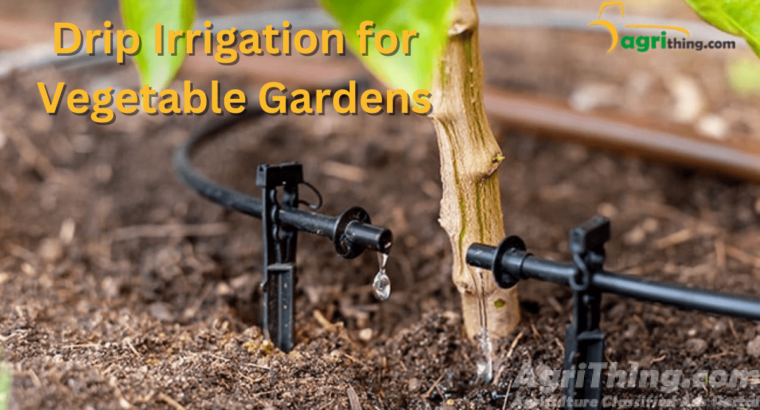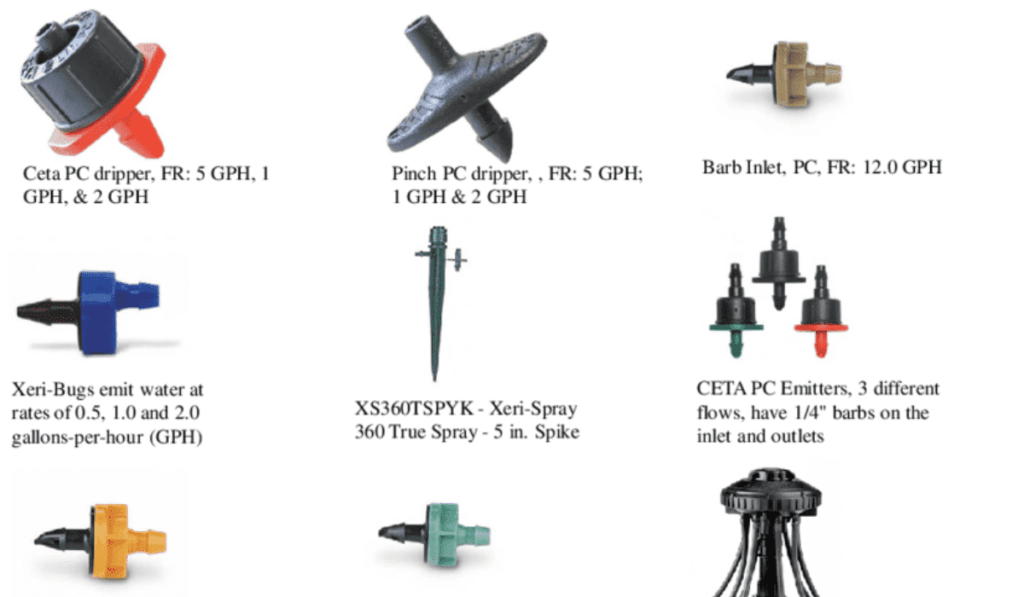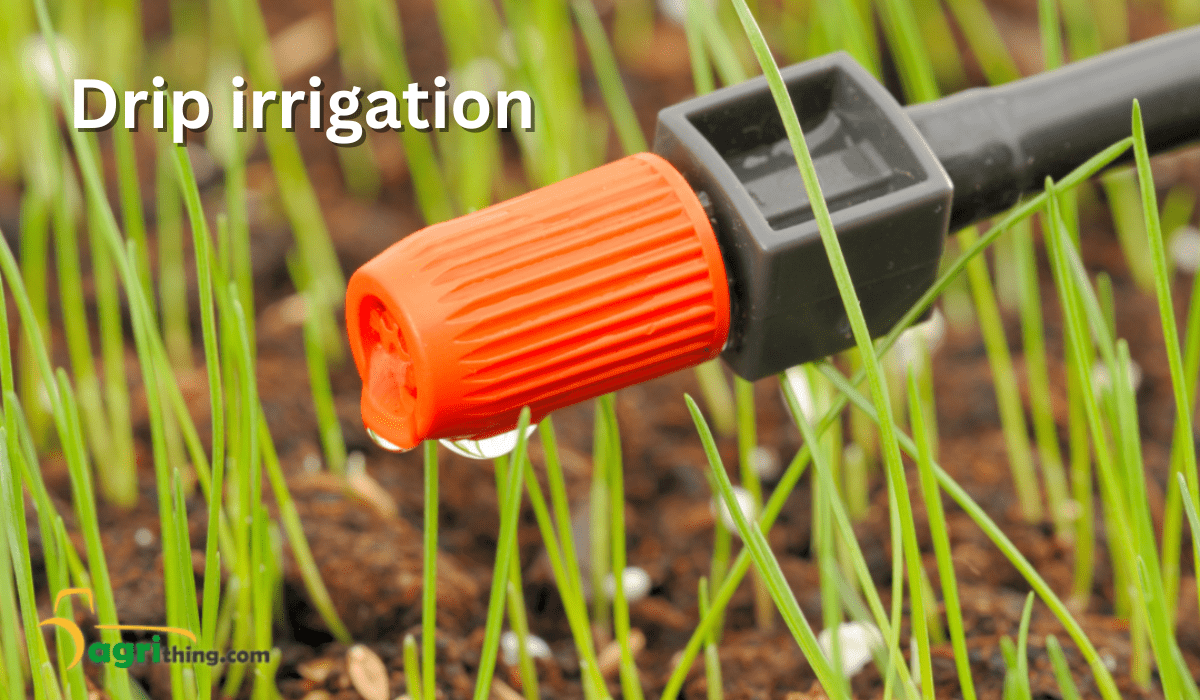Drip Irrigation for Vegetable Gardens: Best Practices

Drip irrigation is a brilliant and efficient way to water gardens, significantly when growing vegetables. It directly targets the roots of plants, providing them with the right amount of water. Compared to traditional watering methods, drip irrigation offers many advantages. In this article, we’ll guide you through planning, installing, maintaining, and troubleshooting a drip irrigation system for your vegetable garden.
Introduction
Vegetable gardens need proper watering to thrive. However, giving them too much or too little water can cause problems and hinder their growth. Drip irrigation is a precise method that delivers water directly to the roots of plants. It helps them grow healthy while conserving water. By learning and following the best drip irrigation practices, you can ensure your vegetable garden is healthy and productive.
Table of Contents
Understands Drip Irrigation
How it works
Drip irrigation slowly and steadily releases water through tubes and emitters placed near the base of plants. These emitters drip water directly to the roots, ensuring a consistent moisture supply. This method is highly efficient because it avoids wasting water through evaporation or runoff.
Components of a drip irrigation system
A typical drip irrigation system has several parts. These include a water source, a filter to prevent clogs, a pressure regulator to control the flow of water, tubing or drip lines, and emitters. You can also add optional components like timers, valves, and pressure-compensating emitters to make the system more efficient and automated.
Types of drip irrigation systems
There are different drip irrigation systems, each with benefits and things to consider. Some common types include surface irrigation, subsurface drip irrigation, and micro-sprinkler systems. The type of system you choose depends on factors such as how your garden is laid out, the types of plants you have, and the available water supply.
Planning and Designing a Drip Irrigation System
Before installing a drip irrigation system, careful planning and design are essential for optimal performance.
Assessing water requirements
To ensure your vegetable garden gets enough water, it’s essential to understand its water needs. It would help to consider the kinds of plants you have, the soil type, the weather, and how quickly water evaporates. This will help you determine how much and often to water your garden.
Calculating drip emitter spacing
To ensure water is evenly distributed in your garden, deciding how far apart to place the drip emitters is essential. This spacing calculation affects how close the plants are to each other, how fast the water flows, and your soil type. When the emitters are appropriately spaced, each plant gets enough water without any waste.


Choosing the suitable drip emitters
Plants have different needs when it comes to water. You can choose the suitable drip emitters for your garden to meet these needs. Adjustable and pressure-compensating flow emitters are good options because they let you customize the amount of water each plant gets. When picking emitters, think about how fast the water flows, how it spreads, and if any filters are needed.
Determining water pressure needs
The pressure of water has an impact on how well the drip irrigation system works. Knowing the water pressure at your source helps you choose the proper pressure regulator and plan the layout correctly. Low-pressure systems are great for gardens because they lower the chances of wasting water and causing damage to the system.
Designing the layout
When designing the layout for your irrigation system, you need to decide where to put the central, sub-main, and lateral supply lines. A well-planned layout ensures that water is distributed efficiently and that there are minimal changes in pressure throughout the system. Factors such as the size of your garden, how many plants you have, and where your water source is located should be considered when designing the layout.
Installation Process
Once you have planned the drip irrigation system, it’s time to install it in your vegetable garden.
Preparing the garden beds
Before installation, prepare the garden beds by removing weeds, rocks, and other debris. It’s also good to amend the soil with organic matter to improve water retention and drainage.
Installing the main water supply line
The main water supply line is like the backbone of your drip irrigation system. You must connect it to your water source using the right fittings and connectors. Installing a filter and a pressure regulator is essential to keep debris out of the system and maintain steady water pressure. These steps are crucial for protecting your irrigation system and ensuring it works properly.
Installing drip lines and emitters
Place the drip lines beside the rows of plants and hold them in place with stakes or clips. Connect the drip emitters regularly, ensuring they are close to the plants’ roots. Check the system for any leaks and fix them if needed.
Flushing and testing the system
Before putting your drip irrigation system into regular operation:
- Flush the lines to remove debris or air bubbles.
- Run the system briefly and check if all emitters are functioning correctly.
- Adjust the flow rates or emitter positions to achieve uniform water distribution.
Maintenance and Operation
Proper maintenance and regular monitoring are crucial for the long-term success of your drip irrigation system.
Monitoring water usage
Keep an eye on how much water you’re using to make sure your plants get enough moisture without wasting any. Change your watering schedule depending on the weather, how your plants are growing, and how moist the soil is.
Adjusting watering schedules
As the seasons change, the amount of water your vegetable garden needs will change too. Adjust your watering schedule so you don’t water too little or too much. Please pay attention to how the plants react to water, which can help you fine-tune the schedules.
Cleaning and maintaining the system
Regularly clean and maintain your drip irrigation system to keep it working well and prevent blockages. Remove any dirt or particles from filters and flush the lines if needed. Check the system for leaks, broken emitters, or other efficiency problems.
Winterizing the drip irrigation system
In regions with freezing temperatures, preparing the drip irrigation system for winter is crucial to avoid damage. Remove all the water from the lines, emitters, and valves to prevent freezing and bursting. Disconnect the system components and store them dry until the next growing season.
Drip irrigation vs. soaker hose for vegetable gardens


| Aspect | Drip Irrigation | Soaker Hose |
|---|---|---|
| Water Distribution | Emits water in controlled, precise droplets | Permeates water through the entire length of the hose |
| Water Efficiency | Highly efficient, minimizes water wastage | Moderately efficient, some water may be lost through evaporation or runoff |
| Installation | Requires a network of tubing and emitters | Simple setup, just lay the hose near the plants |
| Customization | Allows for precise positioning of emitters | Limited flexibility in adjusting water flow to specific plants |
| Uniformity of Watering | Provides even water distribution throughout the garden | Watering may vary, with more water reaching plants near the hose |
| Plant Health | Reduces the risk of fungal diseases and weeds | Can promote weed growth if not properly managed |
| Maintenance | Maintenance Requires periodic cleaning of emitters and filters | Generally low maintenance, occasional inspection may be required |
| Cost | Initial setup cost may be higher | Relatively affordable |
| Frost Protection | Can be equipped with anti-freeze devices | Not suitable for frost protection |
Benefits of Drip Irrigation for Vegetable Gardens
Using drip irrigation in your vegetable gardens offers a range of benefits that contribute to the overall success of your crops.
Water efficiency and conservation
Drip irrigation is a great way to water plants because it delivers water right where the plants need it most, at their roots. This helps prevent water from evaporating or running off, so we don’t waste any. It’s an intelligent way to give plants the needed water while saving water.
Reduced weed growth
Drip irrigation systems deliver water directly to the plant roots, minimizing moisture on the soil surface where weeds often germinate. By reducing weed growth, drip irrigation helps maintain a cleaner and healthier vegetable garden, reducing the need for manual weed removal.
Disease prevention
Drip irrigation reduces the occurrence of foliar diseases by keeping the foliage dry. Unlike overhead watering methods, which can promote fungal growth, drip irrigation directs water to the soil, minimizing the risk of disease development.
Improved plant health and growth
Drip irrigation encourages healthy plant growth and development by providing a consistent and controlled water supply. Plants receive a steady moisture supply, reducing stress and ensuring optimum nutrient uptake. This results in healthier plants with higher yields.
Troubleshooting Common Issues
Despite their efficiency, drip irrigation systems may encounter some common issues that can affect their performance.
Clogged emitters
Clogged emitters can occur due to mineral deposits, algae growth, or debris. Regularly inspect and clean the emitters to ensure they function correctly. Use vinegar or a commercial emitter cleaner to remove mineral deposits.
Uneven water distribution
Uneven water distribution may occur if there are pressure deviations or clogged emitters in the system. Check the water pressure and adjust as needed. Inspect and clean or replace any faulty emitters to ensure uniform watering.
System leaks and breaks
Leaks or breaks in the drip irrigation system can lead to water wastage and reduced performance. Regularly inspect the system for any signs of leaks, such as water pooling or wet spots. Repair or replace damaged components promptly to maintain system efficiency.
Tips for Successful Drip Irrigation
Here are some additional tips to maximize the effectiveness of your drip irrigation system in your vegetable garden:
Mulching around plants
Apply a layer of organic mulch around the plants to conserve moisture, suppress weed growth, and maintain a more consistent soil temperature. Mulching also helps reduce evaporation, ensuring water reaches the plant roots efficiently.
Using timers and moisture sensors
Automate your drip irrigation system by using timers and moisture sensors. Timers allow you to schedule watering times, ensuring that plants receive consistent moisture. Moisture sensors measure soil moisture levels and trigger irrigation only when necessary, preventing overwatering.
Regularly inspecting the system
Perform routine inspections of your drip irrigation system to identify any issues or inefficiencies. Check for leaks, clogs, or damaged components. Promptly address any problems to maintain the system’s optimal performance.
Best drip irrigation kits for vegetable gardens
When choosing a drip irrigation kit for your vegetable garden, several excellent options are available. Here are a few top picks:
Rain Bird Drip Irrigation Kit:
Rain Bird is a well-respected brand famous for its top-notch irrigation products. Their drip irrigation kit is simple to set up and ensures accurate watering for your vegetable garden. It has everything you need, like tubes, emitters, connectors, and stakes.
Flaunter Garden Irrigation System:
The Flantor Garden Irrigation System is a complete small- to medium-sized vegetable garden kit. It has adjustable drippers that let you manage the water flow for various plants. The kit comes with tubing, connectors, emitters, and automated watering timers.
DIG Drip and Micro Sprinkler Kit:
The DIG Drip and Micro Sprinkler Kit is a flexible choice that offers both drip irrigation and micro-sprinkler features. It comes with various components to suit different garden designs and watering requirements. The kit can be expanded so that you can personalize it according to the size of your vegetable garden.
Netafim Drip Irrigation Starter Kit:
Netafim is a renowned brand in the irrigation industry. Their drip irrigation starter kit is specifically designed for vegetable gardens. It features pressure-compensating drippers that guarantee consistent watering and minimize water waste. The kit includes tubing, connectors, stakes, and a filter.
Antelco Drip Irrigation Kit:
The Antelco Drip Irrigation Kit is an affordable choice for small vegetable gardens. It provides a straightforward and effective method of delivering water directly to the roots of plants. The kit includes tubing, connectors, stakes, and adjustable drippers.
Get your 8/12 PVC Branch Pipe Micro Spray for Drip Irrigation, Garden Irrigation, and more at Agricomplex. Don’t wait, shop now!

Conclusion
Drip irrigation is a valuable tool for vegetable gardeners, providing efficient and precise watering that promotes healthy plant growth. By understanding the best practices and following the steps outlined in this article, you can design, install, and maintain a successful drip irrigation system for your vegetable garden. Enjoy the benefits of water conservation, improved plant health, and higher yields as you watch your vegetable garden thrive with the help of drip irrigation.
Frequently Asked Questions (FAQ’s)
Can I use drip irrigation for all types of vegetable plants?
Drip irrigation works for most vegetables, but plants with shallow roots or specific water needs may require alternative methods. Research plant water requirements and seek gardening advice for optimal irrigation.
How often should I water my vegetable garden with a drip irrigation system?
Watering frequency varies based on plant species, weather, soil, and growth stage; monitor soil moisture and adjust accordingly, favoring deep, infrequent watering for better root growth.
Can I connect a drip irrigation system to a rainwater harvesting system?
Connecting drip irrigation to a rainwater harvesting system is eco-friendly, utilizing collected rainwater to irrigate the garden and reducing dependence on the main water supply.
What is the lifespan of drip irrigation components?
The lifespan of drip irrigation components ranges from 5 to 15 years, depending on quality, usage, and maintenance; regular upkeep can prolong system longevity.
Can I install a drip irrigation system on my own?
Installing a drip irrigation system in your vegetable garden can be a DIY project with proper planning, guidance, or professional assistance for a smoother process.
Related Articles on Drip Irrigation
People Also Asked
How does drip irrigation work?
Drip irrigation delivers water directly to the plant’s root zone through tiny tubes and emitters.
What are the benefits of drip irrigation for vegetable gardens?
The benefits of drip irrigation for vegetable gardens include water efficiency, reduced weed growth, minimized disease risk, and improved plant health and yield.
Is drip irrigation better than traditional sprinkler systems?
Drip irrigation is generally considered more efficient and effective than traditional sprinkler systems.
Can I install a drip irrigation system myself?
Yes, installing a drip irrigation system yourself with proper guidance and instructions is possible.
How do I design a drip irrigation system for my vegetable garden?
To design a drip irrigation system for your vegetable garden, determine water requirements, lay out the system, select appropriate components and consider factors such as plant spacing and water pressure.




Leave your comment